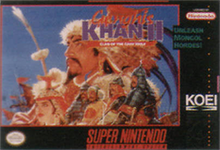Genghis Khan II: Clan of the Gray Wolf
| Genghis Khan II: Clan of the Gray Wolf | |
|---|---|

Super NES cover art
|
|
| Developer(s) | Koei |
| Publisher(s) | Koei |
| Series | Genghis Khan |
| Platform(s) | MSX2, Nintendo Entertainment System, MS-DOS, Sharp X68000, NEC PC-9801, PC-8801, Sega Genesis, Super NES, Sega CD, TurboGrafx-16, PlayStation, Wii (Virtual Console) |
| Release |
PC-8801
Mega CD/Sega CD
Wii U Virtual Console |
| Genre(s) | Strategy |
| Mode(s) | Single-player or two-player game |
Genghis Khan II: Clan of the Gray Wolf, originally released as Aoki Ōkami to Shiroki Mejika: Genchou Hishi (蒼き狼と白き牝鹿・元朝秘史?), is a 1992 video game developed by Koei. It is part of Koei's Historical Simulation Series of games, and is the sequel to Genghis Khan, though this is the third game in the series. Genghis Khan II was developed and published for MSX2, Nintendo Entertainment System, DOS, X68000, PC-9801, PC-8801, Mega Drive/Genesis, Super NES, Sega CD, PC Engine, and later PlayStation. The Super NES version was also made available on the Wii Virtual Console in North America on June 8, 2009 and in Japan on May 11, 2010.
The player is given the option to conquer either the country of Mongolia as Temujin, the man who would one day become Genghis Khan himself, or as one of three other rivals in that region; or to take over the known world of the time as one of several rulers from throughout Europe, mainland Asia, and North Africa. Conquests are made through the balance of economy, population, buying and selling manufactured goods, family relations, promoting and demoting generals, developing military, all in a turn-based fashion. All of these actions can happen only within a given amount of "turn points", so some actions are given priority while others are overlooked. The game also includes a turn-based battle sequence, allowing specific control to the player or delegated to a general.
...
Wikipedia
